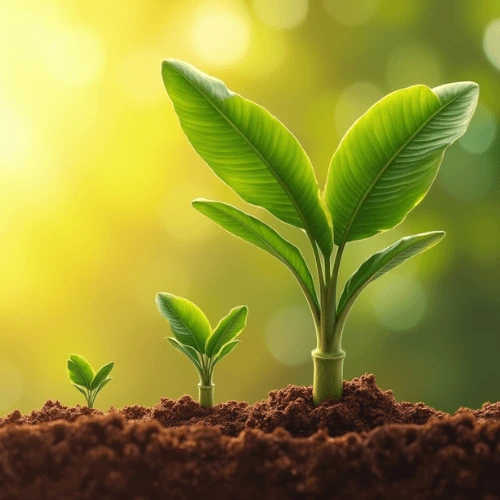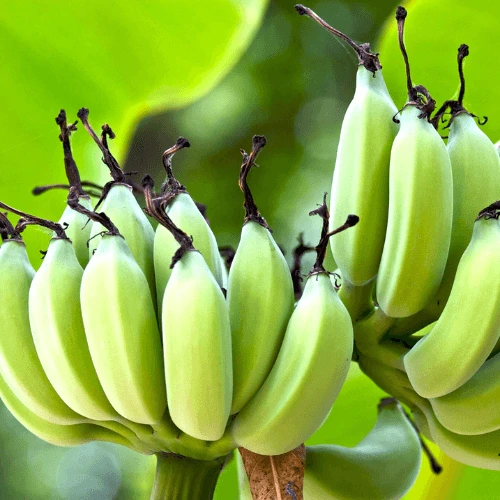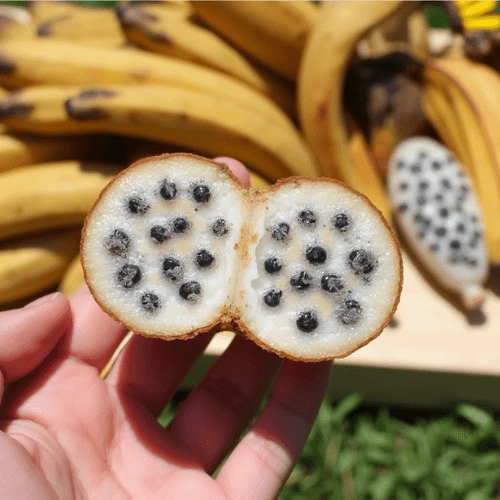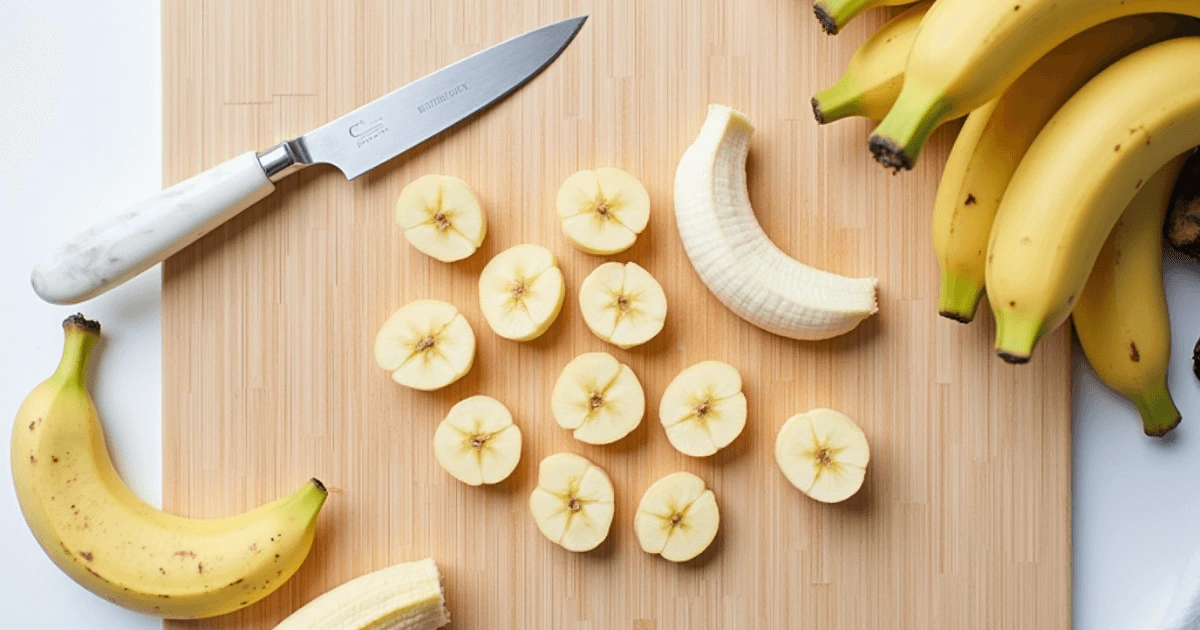Growing banana plants can feel like a tropical dream come true, but have you ever wondered about the role of banana seeds in making that happen? For most of us, bananas are synonymous with smooth, seedless fruits—a staple in our kitchens and gardens. Yet, hidden within the history of this fascinating plant lies a world of seeds, wild varieties, and unique growth challenges that spark curiosity among gardening enthusiasts.
Whether you’re intrigued by the idea of growing a banana tree from scratch or simply want to uncover the mysteries of how bananas reproduce without seeds, this guide will walk you through everything you need to know. So, grab your gardening gloves and let’s explore the exciting journey from banana seeds to thriving plants in your garden!
In This Article
Do Bananas Have Seeds?
When you think of bananas, seeds probably aren’t the first thing that comes to mind. After all, the bananas we commonly buy at the grocery store are smooth and seedless. But did you know that bananas actually do have seeds? Let’s dive into the fascinating world of banana biology to understand this better.
Understanding Banana Fruit Structure
Bananas are technically berries, and like other fruits, they develop from the ovary of a flower. Wild bananas, the ancestors of today’s cultivated varieties, contain hard seeds embedded within their flesh. These seeds are responsible for reproduction in the wild.
In contrast, the bananas we eat—mostly Cavendish bananas—are a product of selective breeding. They are parthenocarpic, meaning they develop without pollination, resulting in seedless fruit. What you see as small black specks inside your banana are actually undeveloped seeds, a remnant of their wild ancestry.
Wild vs. Cultivated Bananas: Key Differences
- Wild Bananas: Found in tropical regions, these fruits are smaller, filled with hard seeds, and less sweet compared to cultivated varieties.
- Cultivated Bananas: Grown for human consumption, they are seedless, sweeter, and easier to eat.
Why Store-Bought Bananas Are Seedless
The bananas we consume today are propagated through cloning. Farmers grow them using methods like planting banana corms or suckers, ensuring consistency in taste and texture. While this makes bananas convenient and delicious, it also means they don’t produce viable seeds.
Banana seeds may not play a role in the bananas you enjoy with your breakfast cereal, but they’re an essential part of the plant’s history and biology. Next time you spot those tiny black dots inside your banana, you’ll know they’re more than just specks—they’re a glimpse into the plant’s wild past.



Can You Grow Bananas from Seeds?
The idea of growing bananas from seeds might sound like a tropical dream, but is it actually possible? The answer is yes: Let’s explore how banana seeds work and what it takes to grow your own banana plant from scratch.
Are Banana Seeds Viable for Growth?
Not all banana seeds are created equal. The seeds found in wild bananas are viable and capable of germinating, while those in the cultivated bananas we eat are not. If you’re planning to grow bananas from seeds, you’ll need to source seeds from wild or specialty varieties such as:
- Musa balbisiana: Known for its hard seeds and drought tolerance.
- Musa acuminata: A wild ancestor of the modern banana.
These seeds are often available online or at gardening specialty stores.
Challenges of Growing Bananas from Seeds
Growing bananas from seeds requires patience and the right conditions. Here are some challenges to consider:
- Long Germination Period: Banana seeds can take anywhere from 3 weeks to 6 months to germinate, depending on the variety.
- Specific Climate Needs: Bananas thrive in tropical and subtropical climates with warm temperatures and high humidity.
- Hard Seed Coats: Many wild banana seeds have tough outer shells, making germination more difficult.
Pro Tips for Success
To increase your chances of success when growing bananas from seeds, follow these steps:
- Scarify the Seeds: Lightly scratch the seed’s surface with sandpaper to help water penetrate and speed up germination.
- Soak Before Planting: Soak the seeds in warm water for 24-48 hours to soften the seed coat.
- Provide Optimal Conditions:
- Choose a well-draining potting mix that is well enriched with organic matter.
- Maintain soil temperatures between 77–86°F (25–30°C).
- Keep the soil moist but not waterlogged.
Is It Worth the Effort?
While growing bananas from seeds is more challenging than using suckers or corms, it’s a rewarding process for avid gardeners. Not only will you gain a deeper appreciation for the plant’s growth cycle, but you’ll also be able to experiment with unique banana varieties that aren’t available in stores.
If you’re up for the challenge, growing bananas from seeds can turn your garden into a tropical paradise, one sprout at a time.
How to Grow Bananas From Seed
Growing bananas from seeds can be a deeply rewarding experience, allowing you to nurture these fascinating plants from their earliest stages. While it takes patience and care, the process isn’t as intimidating as it sounds when you have the right steps to follow. Here’s a complete guide to help you grow banana plants from seeds successfully.
Step 1: Prepare Your Banana Seeds
Banana seeds need some preparation before planting to ensure the best chance of germination:
- Scarify the Seeds: Use sandpaper or a nail file to gently scratch the hard outer layer of the seeds. This process helps water penetrate the seed coat, speeding up germination.
- Soak the Seeds: Place the seeds in warm water and let them soak for 24–48 hours. This softens the seed’s coat and encourages the germination process.
Step 2: Create the Ideal Germination Environment
Banana seeds thrive in specific conditions:
- Choose the Right Soil: Use a mix of well-draining potting soil combined with compost or organic matter. This ensures proper aeration and nutrients for the seeds.
- Optimal Temperature: Keep the soil temperature between 77–86°F (25–30°C). A heated propagator or a warm indoor spot can help maintain consistency.
- Moisture Matters: Ensure the soil is damp but not waterlogged. Covering the planting tray with plastic wrap or a clear lid can help retain humidity.
Step 3: Planting the Seeds
- Fill a number of small pots or seed trays with the prepared soil mixture.
- Plant all the seeds about 1 inch deep, covering them lightly with soil.
- Label your pots if you’re growing multiple banana varieties to keep track.
Step 4: Be Patient
Banana seeds can take anywhere from 3 weeks to 6 months to germinate, so patience is key. Regularly check for:
- Signs of Growth: Look for small sprouts emerging from the soil.
- Consistent Conditions: Ensure the soil stays warm and slightly moist throughout the germination period.
Step 5: Transplanting Seedlings
Once your banana seedlings have sprouted and developed a few leaves, they’re ready to be transplanted:
- Choose a Larger Pot or Outdoor Spot: Select a location with plenty of sunlight and space for the plant to grow.
- Handle with Care: Gently remove the seedling from its pot to avoid damaging the fragile roots.
Bonus Tips for Success
- Fertilize Regularly: Opt for a balanced formula to supply the essential nutrients needed for robust growth.
- Monitor for Pests: Keep an eye out for common pests like aphids or spider mites and treat promptly.
- Provide Support: As the plant grows, consider staking it to prevent bending or breakage.
Growing bananas from seeds is a fulfilling journey that connects you to the plant’s natural lifecycle. With the right preparation and care, you’ll soon enjoy watching your banana plants flourish, turning your garden into a lush, tropical oasis.
How to Plant Banana Seedlings
Once your banana seeds have sprouted into seedlings, the next step is to plant them in a suitable environment where they can thrive. Whether you’re growing them outdoors or in pots, proper planting techniques can make all the difference in ensuring healthy growth. Let’s explore both methods in detail.
Planting Outdoors
Outdoor planting is ideal if you live in a tropical or subtropical climate with plenty of sunlight and warmth. Follow these steps for success:
- Choose the Perfect Spot
- Look for a location with full sunlight, as bananas need at least 6–8 hours of direct sunlight daily.
- Ensure the area is sheltered from strong winds to prevent damage to the plant’s leaves.
- Prepare the Soil
- Opt for fertile, well-draining soil that is abundant in organic matter.
- Test the soil’s pH level, aiming for a slightly acidic to neutral range (5.5–7.0).
- Mix compost or aged manure into the soil to boost nutrient content.
- Plant the Seedling
- Dig a hole twice as wide and slightly deeper than the seedling’s root ball.
- Place the seedlings in the hole, ensuring the top of the root ball is level with the ground.
- Backfill with soil, gently firming it around the base of the plant to eliminate air pockets.
- Water Thoroughly
- Water the seedling immediately after planting to help the roots settle.
- Maintain consistent moisture, especially during the early growth stages, but avoid overwatering to prevent root rot.
Growing in Pots
If outdoor space or climate conditions aren’t ideal, growing banana plants in pots offers a flexible alternative. Here’s how to do it:
- Select the Right Container
- Choose a large pot with a diameter of at least 18–24 inches to accommodate the plant’s roots.
- Ensure your pot is one with multiple drainage holes to prevent waterlogging.
- Use the Best Potting Mix
- Fill the pot with a well-draining potting mix enriched with organic compost.
- Avoid using garden soil, which can compact and hinder root growth in containers.
- Plant the Seedling
- Place the seedling in the center of the pot, ensuring its roots are evenly spread.
- Cover with potting mix, leaving about 1–2 inches of space from the rim for watering.
- Care for Your Potted Banana Plant
- Position the pot in a location with plenty of sunlight, such as a south-facing window or balcony.
- Turn the pot periodically to guarantee uniform light exposure.
- Water consistently, keeping the soil moist but not soggy.
Additional Tips for Both Methods
- Fertilize Regularly: Feed your banana plant every 2–4 weeks with a balanced fertilizer to encourage healthy growth.
- Mulch to Retain Moisture: Add a layer of organic mulch around the base of the plant to conserve soil moisture and regulate temperature.
- Monitor for Pests and Diseases: Check for signs of common issues like aphids, fungal infections, or leaf spots, and treat them promptly.
Whether planted outdoors or in pots, banana seedlings can thrive with the right care. By creating a nurturing environment, you’ll set the stage for a vibrant, fruit-producing banana plant that adds beauty and utility to your garden or home.
How Bananas Produce Fruit
Bananas are fascinating plants that undergo a unique process to produce their sweet, iconic fruit. Understanding how bananas grow and develop fruit can deepen your appreciation for this tropical treasure and help you care for your plants more effectively. Let’s explore the fruiting process in detail.
The Flowering Process
Bananas grow from an underground rhizome, which sends up a pseudostem (a false stem made of tightly packed leaf bases). After about 9–12 months, depending on the variety and growing conditions, the plant produces a flower, signaling the start of the fruiting phase.
- Banana Flower Development
- The flower, also known as an inflorescence, emerges from the center of the pseudostem.
- It consists of layers of bracts (modified leaves) that protect rows of tiny flowers.
- Female and Male Flowers
- The first flowers to appear are female flowers, which eventually develop into fruit.
- Male flowers follow, located farther down the stem, but they don’t contribute directly to fruit formation in cultivated bananas.
Pollination and Fruit Formation
In wild bananas, pollination is necessary for fruit development, often facilitated by bats, birds, or insects. However, most cultivated bananas, such as the Cavendish variety, are parthenocarpic, meaning they produce fruit without pollination.
- Parthenocarpic Fruiting: This process allows bananas to develop seedless fruit, which is why store-bought bananas lack viable seeds.
- Timeframe for Fruit Growth: Once the flower appears, it typically takes 2–4 months for the fruit to mature, depending on environmental factors.
Banana Bunch Development
Bananas grow in clusters called “hands,” which together form a bunch. Here’s what to expect as the fruit develops:
- Early Stage: The bananas are green and firm, gradually increasing in size.
- Ripening: The fruit softens and turns yellow as starches convert to sugars.
- Harvesting: Bananas are usually harvested while still green to prevent damage during transport and storage.
Factors That Influence Fruiting Success
For healthy banana plants and successful fruiting, consider the following:
- Climate and Sunlight
- Bananas thrive in tropical and subtropical climates with plenty of sunlight.
- Ensure your plant gets 6–8 hours of direct sunlight daily.
- Soil and Nutrients
- Use rich, well-draining soil with a pH of 5.5–7.0.
- Regularly fertilize with potassium-rich fertilizers to support fruit development.
- Watering
- Maintain moist soil without overwatering
- Spread a layer of organic mulch around the base to help conserve moisture and keep weeds under control.
- Pest and Disease Management
- Watch for common issues like banana weevils, nematodes, or fungal diseases.
- Address problems early with organic or chemical treatments as needed.
Enjoy the Fruits of Your Labor
The process of producing bananas is as rewarding as it is fascinating. By understanding the plant’s natural growth cycle and providing the care it needs, you can enjoy fresh, homegrown bananas while transforming your garden into a tropical haven.
FAQ
Does a banana have seeds?
Yes, bananas do have seeds! Wild bananas contain large, hard seeds, but the bananas we typically eat, like the Cavendish variety, are seedless due to selective breeding. The tiny black dots in store-bought bananas are undeveloped seeds, a remnant of their wild ancestors.
Can I grow a banana tree from a banana?
No, you can’t grow a banana tree directly from a store-bought banana. These bananas are seedless and lack viable seeds for germination. To grow a banana tree, you’ll need to use banana seeds from wild varieties or propagate it using corms or suckers.
What happened to banana seeds?
Banana seeds have largely disappeared in cultivated varieties due to human intervention. Through selective breeding, seedless bananas became the preferred choice for consumption because they are easier to eat and grow consistently. However, wild bananas still produce seeds and are used for growing and breeding purposes.
How do bananas reproduce without seeds?
Bananas reproduce asexually via a process called vegetative propagation. Farmers use parts of the plant, such as corms or suckers, to grow new banana plants. This method ensures that the new plants are genetically identical to the parent, making it ideal for cultivating seedless varieties.
Conclusion
Bringing banana seeds to life and nurturing them into vibrant, fruit-bearing plants is a rewarding journey that connects you to the natural world in a unique way. Whether you’re experimenting with wild banana varieties or expanding your gardening skills, every step of the process offers an opportunity to learn and grow.
So, are you ready to take on the banana seeds challenge and turn your garden into a tropical paradise? With the right care and a little patience, you’ll soon see those first green shoots and experience the joy of cultivating your own banana plant. Remember, every great gardener started with a single seed—why not let yours be a banana?

